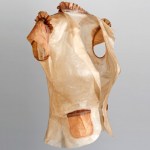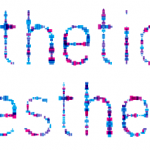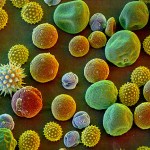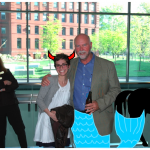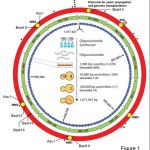synthetic biology
A recent survey of 3,000 people worldwide found what many have known all along--that Legos are the best toy ever made. For synthetic biologists, this doesn't come as much of a surprise--Legos are at the heart of the concepts underlying the basics of synthetic biology.
Legos are a favorite analogy for BioBricks, the DNA parts that are made to easily "snap" together using a shared genetic engineering strategy. The iGEM competition is structured around BioBricks, with undergraduate teams combining old and creating new BioBricks for the Registry of Standard Biological Parts, competing for the…
It turns out that my wonderful iGEM students, besides being brilliant scientists, are also excellent, hilarious actors. Please enjoy their Jersey Shore inspired video about molecular cloning:
My Synthetic Aesthetics partner, Sissel Tolaas, is featured in the terrific current issue of the German interview magazine mono.kultur. Her work focuses on smell, exploring the unique smellscapes of different cities, creating provocative scents to show in art galleries, branded "logo" scents for Adidas, "Swedish" scents for Ikea, and therapeutic memory-triggering scents, part of the healing process for patients dealing with traumatic experiences. Until we have smell-o-vision, her work is almost aggressively analog--"beyond what is seen and heard to something indiscernible yet more…
I recently found this fascinating (relatively) old review article (open access) by awesome MIT professor Natalie Kuldell about teaching synthetic biology. Synthetic biology has integrated teaching and learning with the development of the field since basically the beginning of the field, with students contributing to new technologies through iGEM and academic lab-based courses. By actively participating in a new field students get a unique educational experience, and the field benefits through the work of students being trained as engineers and biologists:
Synthetic biology, with its inclusive…
I don't usually like to post links from BoingBoing because I imagine everyone has already seen this already, but as it is about some of my favorite things (synthetic biology, biomaterials, and fashion) I couldn't resist!
Designer Suzanne Lee makes clothes using cellulose-based fabrics made entirely by cultures of yeast and bacteria. From what I could understand from the ecouterre article, the process is similar to how kombucha is made, using the microbes to ferment a green tea mixture, although I thought that the film that forms on top of the fermenting tea in kombucha is some sort of yeast/…
I am thrilled to announce that I will be one of the Synthetic Aesthetics residents this fall. Synthetic Aesthetics is a new program run through Stanford and the University of Edinburgh and funded by the National Science Foundation and the UK's Engineering and Physical Sciences Research Council that asks the question "how would you design nature?":
Synthetic Biology is a new approach to engineering biology, generally defined as the application of engineering principles to the complexity of biology. Biology has become a new material for engineering. From biological circuits made from DNA to…
There's a terrific new article about synthetic biology in SEED by James King, go check it out! Here's a little taste:
"Synthetic biology" is a catch-all label liberally applied to a host of methods for designing and constructing living things. Given the term's multiple definitions, one of Synthia's most immediately useful applications may be to place the achievement it represents within the context of synthetic biology's various flavors, in order to clarify what the creation of artificial life might actually mean.
In a recent conversation about the safety and ethics of synthetic biology in the wake of the announcement of the synthetic genome, many of the professors I was chatting with commented on how they hoped new synthetic biology technology would lead to bacteria that could eat the oil spilling into the gulf of mexico even as I type this right now. Of course, the "technology" for oil eating bacteria already exists and have already been used for clean up in previous oil spills--many naturally occurring species of bacteria can already break down the hydrocarbons in crude oil. The natural oil eaters…
Silk is an amazing biomaterial, cultivated and prized for more than 5,000 years. The silk threads that we weave into our shiny fabrics are actually enormous protein crystals produced by insects. This industrial silk that you can buy at the mall is made by silkworms, which use the silk to form the cocoon that protects them as they transform into moths. Many other species of insect also produce silk proteins to protect themselves or their eggs, get around, or catch their prey, but none in such enormous quantity in such easy to harvest packages as the silkworm. Silks from different species are…
Biosafety has been on everyone's mind this week after the announcement of the J. Craig Venter Institute's successful transplantation of a synthetic genome. What horrible pathogen will future bioengineers be able to design? What unforeseeable environmental catastrophe will befall us upon the release of genetically engineered bacteria? These are hugely important questions as research in synthetic biology moves forward, being discussed in congressional hearings and as an integral part of every new synthetic biology design.
As the major proposed goal of a great deal of synthetic biology research…
I had the pleasure of chatting with John Hawks about the two big science news stories of the past few months, the synthetic genome and the Neandertal genome, for Science Saturday at bloggingheads.tv.
John is a professor of anthropology at the University of Wisconsin who studies population genetics of ancient humans, as well as a terrific teacher. I learned a lot of really fascinating things about how people study fossils and trace human evolution and it was interesting to find some connections between the two stories! As he mentions on his blog, we didn't once mention synthetic Neandertals…
I don't get nearly as many emails asking for advice as I'm sure the lovely and talented Dr. Isis does, and I'm not sure if my advice can compare in quality and sassiness to hers, but I want to address the questions I get most often--how do you get into synthetic biology if your background is in something else, and how do you get into a PhD in synthetic biology?
While there are an increasing number of labs that work primarily on synthetic biology and schools with undergraduate iGEM teams, there are still very few (if any?) graduate programs that will write "Synthetic Biology" on your diploma,…
There is an interesting and very thoughtful piece by Craig Venter and Daniel Gibson in today's Wall Street Journal going through what their breakthrough is and what it isn't, where they see the project going in the future, and why public discussion is important:
[Previous genetic engineers] did not create life in a test tube, nor did we create life from scratch. We transformed existing life into new life. We also did not design and build a new chromosome from nothing. Rather, using only digitized information, we synthesized a modified version of the naturally occurring Mycoplasma mycoides…
After years of painstaking research and experimentation, genomic pioneer J. Craig Venter has accomplished a long-awaited goal: he and his team at the J. Craig Venter Institute have introduced a synthetic genome into bacterial cells that can grow and replicate itself. Some have gone as far as calling this engineered bacterium a new form of artificial life, though Venter has opted for the term "synthetic cell." Whatever you call it, it's a major milestone in the growing field of synthetic biology. Christina Agapakis and PZ Myers had some of the first in-depth reactions to the breaking news. And…
A recent New York Times article tells us that what many people call food allergies are actually simple intolerances, and that allergies are being dangerously overdiagnosed. What is a true food allergy, and what can be done to fix them besides banning peanuts from schools and avoiding foods that make us itchy?
Allergies are caused by an inappropriate immune response to common things in the environment. Usually the offending allergen is a protein that comes from plants or animals like pollen or dander. Instead of the immune system recognizing that these proteins are harmless, it instead…
The reaction to the Venter Institute's synthetic genome transplantation has been decidedly mixed. Is this the beginning of something new and wonderful, the ability to really design organisms from scratch? Is it something more sinister, the beginning of a dark era where techno-corporate (or terrorist) interests can design something that will destroy the environment in catastrophic ways? Is it just a technical advance or a conceptual breakthrough? A philosophical revolution? Is it a Big Deal or big whoop? Synthetic biology has never been just one thing and still has many different goals, with a…
This is a pretty old video we made about Craig Venter that I've shared before on Hydrocalypse, but I think now is a good time to share it again. When Craig isn't creating synthetic bacteria, he's sailing the world, searching the oceans for interesting DNA sequences. We were inspired by this lifestyle (and sometimes even his science too) and SNL, and from that came Venter's on a Boat, by Hydrocalypse Industries (warning: the song contains a lot of bad language):
The J. Craig Venter Institute has just announced the creation of the first bacterial cell controlled by a genome that is entirely chemically synthesized (PDF). The group has been working towards this goal for several years now, first working out how to synthesize and assemble such large pieces of DNA and how to transplant a genome from one organism to another. This result puts it all together, a synthetic version of the genome of the bacterium Mycoplasma mycoides and transplantation into a Mycoplasma capricolum cell. This synthetic cell is almost identical to a natural M. mycoides, but also…
Are aliens little green men of unpredictable motives? Horrible insect-like face-hugging, chest-exploding monsters? Are they super-smart, super-slimy, super-fishy, body-cavity-probing, disc-flying creatures, searching for planets to colonize and people to destroy as Stephen Hawking warned, or are they something much more mundane? Could there be alien life already on earth, too microscopic, too different to notice? Could life on earth have been seeded from an alien land, with secret messages encoded in our DNA? We've been scanning the sky for extraterrestrial radio signals for years, should we…
I've been co-teaching a short class on synthetic biology this spring through the MIT High School Studies Program (HSSP). The program is awesome, I took classes through a similar MIT program as a nerdy middle schooler and have had a great time teaching the past few weeks (if you're in the Boston area I highly recommend checking it out as a student or as a volunteer teacher!). My students were terrific--smart, open to new and crazy ideas, thoughtful about bioethics issues, and enthusiastic about thinking about what biology can do and designing new biological species.
Today was our last day of…


